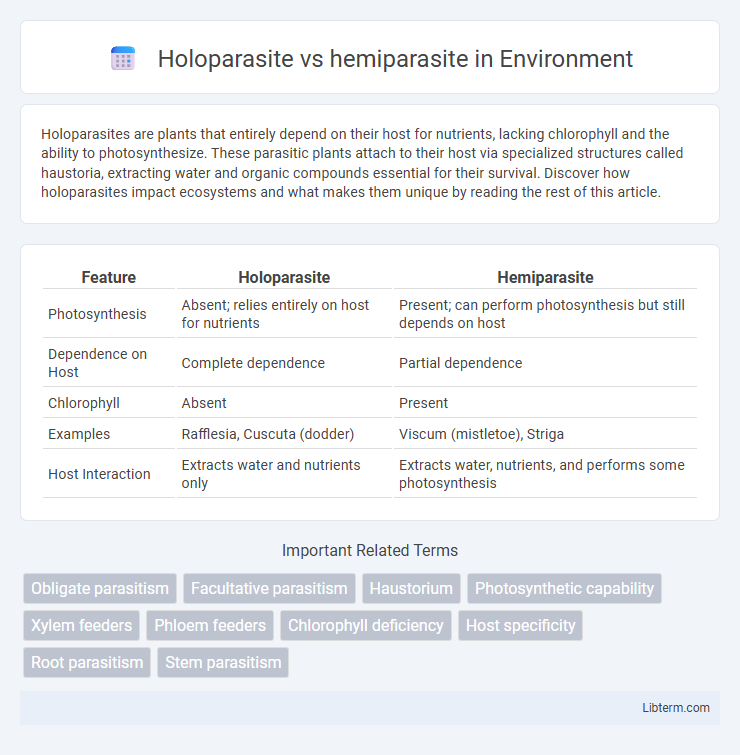Holoparasites are plants that entirely depend on their host for nutrients, lacking chlorophyll and the ability to photosynthesize. These parasitic plants attach to their host via specialized structures called haustoria, extracting water and organic compounds essential for their survival. Discover how holoparasites impact ecosystems and what makes them unique by reading the rest of this article.
Table of Comparison
| Feature | Holoparasite | Hemiparasite |
|---|---|---|
| Photosynthesis | Absent; relies entirely on host for nutrients | Present; can perform photosynthesis but still depends on host |
| Dependence on Host | Complete dependence | Partial dependence |
| Chlorophyll | Absent | Present |
| Examples | Rafflesia, Cuscuta (dodder) | Viscum (mistletoe), Striga |
| Host Interaction | Extracts water and nutrients only | Extracts water, nutrients, and performs some photosynthesis |
Introduction to Plant Parasitism
Holoparasites are plants that completely rely on their host for water, nutrients, and organic compounds, lacking chlorophyll and the ability to photosynthesize. Hemiparasites possess chlorophyll and can photosynthesize but extract water and minerals from the host plant, partially depending on it for sustenance. Plant parasitism represents a specialized form of symbiosis where parasitic plants obtain resources from host plants, affecting host growth and ecosystem dynamics.
Definition of Holoparasites
Holoparasites are fully parasitic plants that lack chlorophyll and rely entirely on their host for water, nutrients, and organic compounds. Unlike hemiparasites, holoparasites cannot perform photosynthesis and depend exclusively on their host's vascular system for survival. Common examples include species in the genus *Cuscuta* and *Rafflesia*.
Definition of Hemiparasites
Hemiparasites are plants that conduct photosynthesis while obtaining water and nutrients from their host through specialized structures called haustoria. Unlike holoparasites, which are completely dependent on their hosts for survival due to lack of chlorophyll, hemiparasites possess chlorophyll and can produce their own food. This partial independence allows hemiparasitic plants to thrive in various ecosystems by supplementing their nutrition through parasitism rather than total reliance on the host.
Key Differences Between Holoparasites and Hemiparasites
Holoparasites are fully parasitic plants that lack chlorophyll and depend entirely on their host for water, nutrients, and organic compounds, whereas hemiparasites possess chlorophyll and can perform photosynthesis, relying partially on their host for water and minerals. Holoparasites typically exhibit reduced or absent leaves and rely completely on host plants, while hemiparasites have functional leaves and retain some autotrophic capacity. The energy acquisition difference is the key distinction, with holoparasites being obligate parasites and hemiparasites often considered facultative or partial parasites.
Morphological Adaptations of Holoparasites
Holoparasites exhibit specialized morphological adaptations such as the absence of chlorophyll, leading to non-photosynthetic lifestyles that rely entirely on host plants for nutrients. Their roots modify into haustoria, which penetrate the host's vascular system to extract water and organic compounds efficiently. These adaptations contrast with hemiparasites, which retain chlorophyll and possess structurally developed leaves for partial photosynthesis while also forming haustoria for parasitism.
Physiological Traits of Hemiparasites
Hemiparasites possess chlorophyll and conduct photosynthesis, enabling partial self-nourishment while extracting water and nutrients from host plants through specialized haustoria. Their leaves typically exhibit functional stomata, supporting gas exchange and contributing to energy production. Physiologically, hemiparasites balance autotrophic and heterotrophic mechanisms, often showing adaptations like enhanced xylem connections to efficiently tap host resources without complete dependency.
Examples of Holoparasitic Plants
Examples of holoparasitic plants include species like *Rafflesia arnoldii*, known for its enormous flowers, and *Cuscuta* (dodder), which lacks chlorophyll and relies entirely on host plants for nutrients. Other notable holoparasites are *Orobanche* (broomrape) and *Hydnora*, both of which completely depend on their host plants for survival, unlike hemiparasites that retain some photosynthetic ability. These holoparasites attach to the roots or stems of host plants and extract water and nutrients through specialized structures called haustoria.
Notable Hemiparasitic Plant Species
Notable hemiparasitic plant species include mistletoes (Viscum spp.), witchweeds (Striga spp.), and Indian paintbrushes (Castilleja spp.), which partially rely on photosynthesis while extracting water and nutrients from host plants. These hemiparasites possess chlorophyll, allowing them to produce some of their own food, unlike holoparasites such as dodders (Cuscuta spp.) that entirely depend on their hosts. Hemiparasitic plants play significant roles in ecosystems by influencing host plant populations and biodiversity dynamics.
Ecological Roles and Impacts
Holoparasites, such as Rafflesia and dodder, rely entirely on their host plants for water, nutrients, and photosynthates, causing significant stress and sometimes death to hosts, thereby strongly influencing plant community dynamics and nutrient cycling. Hemiparasites like mistletoe partially photosynthesize, extracting water and minerals from hosts while contributing to habitat heterogeneity and supporting diverse animal species by providing food and nesting sites. Both holoparasitic and hemiparasitic plants play crucial roles in shaping ecosystem structure, influencing species interactions, and driving evolutionary processes.
Conclusion: Comparative Insights
Holoparasites are completely dependent on their host plants for water, nutrients, and photosynthates, lacking chlorophyll and losing photosynthetic ability, whereas hemiparasites retain some photosynthetic capacity and can produce their own energy while extracting water and minerals from the host. The ecological roles of holoparasites often involve severe host dependency leading to significant host damage, contrasting with hemiparasites that typically impose moderate stress due to partial autonomy. Understanding these distinctions highlights the evolutionary strategies and physiological adaptations driving parasitic plant diversity and their differing impacts on host communities.
Holoparasite Infographic

 libterm.com
libterm.com